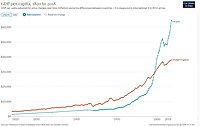
Photo from wikipedia
Abstract We examine the role of fiscal policy in accounting for the remarkable rise of Ireland from one of Western Europe’s poorest countries to one of its richest in just… Click to show full abstract
Abstract We examine the role of fiscal policy in accounting for the remarkable rise of Ireland from one of Western Europe’s poorest countries to one of its richest in just a few years. We focus on the importance of business tax reform and overall changes in fiscal policy, in conjunction with other factors, which we model as a residual rise in Total Factor Productivity (TFP). We conduct our analysis using a two-sector, small open economy model where production requires tangible and intangible capital services, and where inflows of capital are limited by a collateral constraint (disciplined to account for the GNP to GDP gap). We find that the much discussed reductions of business taxes played a significant, but secondary, role in the Irish miracle. However, tax reform and other changes strongly reinforce each other. We also find that Ireland’s openness to capital movements was crucial: under the same driving forces, a closed economy would have experienced a significantly smaller rise in GDP.
Journal Title: Journal of Monetary Economics
Year Published: 2020
Link to full text (if available)
Share on Social Media: Sign Up to like & get
recommendations!